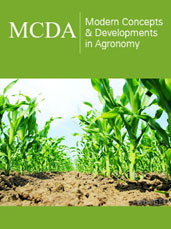Bibliometric Analysis of the Journal of
Orthopaedic Research from 1991 To 2018 by Yuh-Shan Ho in Orthopedic Research Online Journal_orthopedic research online journal
Abstract
A chronological survey of papers was conducted to investigate the journal titled Journal of Orthopaedic
Research in Science Citation Index Expanded (SCI-EXPANDED) between 1991 and 2018. Performances
of countries, institutes, and authors, including total, single, collaborative, first author, and corresponding
author publications were analyzed. Citation indicators including the total number of citations since
publication to the end of 2018, the number of citations in 2018, total number of citations in the publication
year, total number of citations per number of years, and citations per publication were applied to
evaluate highly cited articles. Comparison of the articles contributing most to impact factor and highly
cited articles were discussed. In addition, journal impact factor contributors and journal impact factor
contributing articles were presented.
Keywords: Bibliometric; SCI-EXPANDED; Citations per publication; Journal impact factor contributing
articles; JIF contributors
Introduction
The bibliometric analysis of publications can provide insight to improve the understanding
by editors and readers of an academic journal’s direction [1]. The Journal of Orthopaedic
Research with ISO Abbreviation title J Orthop Res has been indexed in the Science Citation
Index Expanded (SCI-EXPANDED) and classified in Web of Science category of orthopedics
since 1985. In this category, bibliometric analyses of journals have been reported to investigate
journals’ development and impact in research fields, including journals Physical Therapy [2,3],
Journal of Orthopaedic & Sports Physical Therapy [4], Acta Orthopaedica et Traumatologica
Turcica [5], International Orthopaedics [6], Knee [7], Journal of Orthopaedic Trauma [8],
and Spine [9]. Recently authorship trends in the Journal of Orthopaedic Research [10] and
a bibliometric analysis of classic publications in Web of Science category of orthopedics
[11] were also reported. Document types, languages, publication trends, and publications of
country, institution, and author were generally revealed to provide basic information about a
journal [1,12]. In addition, journals’ impact factor, which was created in the early 1960s [13],
has become a staple in many types of analyses of a journal’s scientific impact [14]. Publication
indicators such as total, independent, collaborative, first author, and corresponding author
publications [15] as well as citation indicators including the total number citations from Web
of Science Core Collection since publication to the end of the most recent year [16,17] and the
number of citations in the most recent year [18] were generally applied to evaluate journals
[1,19].
In this study, the bibliometric method was employed to obtain an overview of Journal
of Orthopaedic Research from 1991 to 2018. General analysis including publication
characteristics and trends were presented. Furthermore, relationship among journal’s impact
factor, its contributors, and highly cited publications were discussed.
Methodology
Documents used in this study were derived from the Science Citation Index Expanded
(SCI-EXPANDED) of the Web of Science core Collection, Clarivate
Analytics (formerly known
as the Thomson Reuters and the Institute for Scientific Information).
The keyword phrase
“Journal of Orthopaedic Research” was searched as publication name based
on SCI-EXPANDED
(updated on 20 November 2019). All document information from
SCI-EXPANDED was
checked and downloaded into Microsoft Excel 2016 [20,21]. Collaboration
type of country and institution was determined by the affiliation of the
authors. In
the SCI-EXPANDED, the corresponding author is designated as the
“reprint” author; this study uses as the term “corresponding author”
[18]. In a single author article where authorship is unspecified,
the single author is both first author and corresponding author
[22]. Similarly, in a singly institutional article, the institution is
classified as the first author institution and the corresponding
author institution [22]. Only the last corresponding authors were
considered in articles having multiple corresponding authors.
Affiliations originating from England, Scotland, Northern Ireland,
and Wales were reclassified as being from the United Kingdom (UK)
[23]. Affiliations in Hong Kong before 1997 were included with
China [24].
Results and Discussion
Characteristics of document type
The distributions of document types at the Web of Science and their citations per publication (CPPyear= TCyear/TP) have been analyzed for journals by Ho’s group, for example Polish Journal of Environmental Studies [25], Journal of Membrane Science [1], and Revista de Biología Tropical/International Journal of Tropical Biology and Conservation [12]. Journal
of Orthopaedic Research published 5,589 documents in 11 Web of Science
document types from 1991 to 2018 (Table 1). Article (5,329) was the
dominant document type comprising 95% of 5,589 productions with the
third ranking of APP (5.8), followed by letters (1.4%),
proceedings papers (1.3%), and reviews (1.1%). Among the 11 document
types, proceedings papers had the highest CPP2018 of 50, followed by articles with CPP2018 of 33, notes (17), and reviews (16). It should be pointed out that CPP2018 of review is much lower than that of articles. Proceedings papers had the highest number of authors per publication (APP=8.5) followed by corrections (5.9). Only the articles were used for further study.
Table 1: Document types for Journal of Orthopaedic Research (1991-2018).
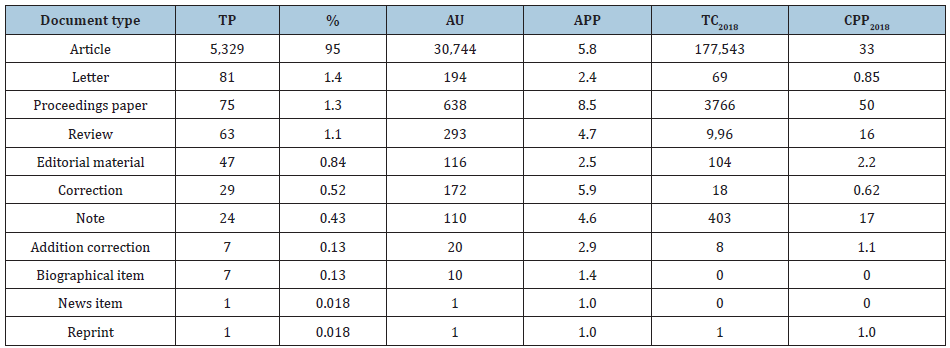
TP: Number of publications; AU: Number of authors; APP: Number of authors per publication; TC2018: The total number
of citations from Web of Science Core Collection since publication to the end of 2018; CPP2018: number of citations
(TC2018) per publication (TP).
Characteristics of journal’s Impact Factor (IF)
According to the Journal Citation Reports (JCR) in 2018, JCR indexed
9,258 journals with citation references across 178 Web of Science
categories in SCI-EXPANDED. The journal impact factor (IF) is
defined as all citations to the journal in the current JCR year to items
published in the previous two years, divided by the total number of
scholarly items (these comprise articles, reviews, and proceedings
papers) published in the journal in the previous two years.
The journal impact factor has a simple formula:

where IFyear is journal impact factor in a specific JCR year, Cyear-2: citations from JCR year to items in “year - 2”, Cyear-1: citations from JCR year to items in “year - 1”, TPyear-2: citable items in “year - 2”, TPyear-1:
citable items in “year - 1”. The denominator is comprised of three
document types such as reviews, articles, and proceedings papers. An
item with any other document type is excluded from the denominator.
The top 21 most impact factor contributing articles were listed in
Table 2. 29% and 14% of them were published in 2007 and 2009
respectively and 10% were published in 2015, 2011, 2005, and 2003
respectively. Only one top impact factor contributing article was
published in 2012, 2008, 2004, and 2002, respectively. 67% and 52% of
the top 21 most impact factor contributing articles were ranked top 21
in terms of TCyear-2 and TCyear-1
respectively. However, only 14%, 14%, 24%, and 57% of the top 21 most
impact factor contributing articles were ranked top 21 in terms of C0, total number of citations from web of science core collection in publication year [15]; TC2018, total number of citations from web of science core collection since publication to the end of 2018 [16,17]; C2018, total number of citations from web of science core collection in 2018 [18], and TCPY, total number of citations per number of year, TC2018/year
[18] respectively. Furthermore, only 47% and 34% of the top 100 impact
factor contributing articles were found in the top 100 articles in terms
of C2018 and TC2018,
respectively. Article entitled “Post-traumatic osteoarthritis: Improved
understanding and opportunities for early intervention” by Anderson et
al. [26] from USA was not the top high impact factor contributing
article (ranked 1st) but also the most impact article in the recent year with C2018 of 35 (ranked 5th) in J Orthop Res However the article ranked 40th in TC2018
with 243. It was generally accepted that time is needed to accumulate
total number of citations for an article. Similarly, article entitled
“Distribution of in situ forces in the anterior cruciate ligament in
response to rotatory loads” by Gabriel et al. [27] from University of
Pittsburgh in USA was not the top high impact factor contributing
article (ranked 6th) but also the highly cited with TC2018 of 383 (ranked 11th).
It can be concluded that the impact factor of journal is used to
evaluate a journal’s relative importance, especially when compared to
others in the same field but not appropriate to be used when compared to
individual research performance. It was also reported in web of science
that the journal impact factor is a publication-level metric. It does
not apply to individual papers or subgroups of papers that appeared in
the publication. Additionally, it does not apply to authors of papers,
research groups, institutions, or universities.
Table 2: Top 21 journal impact factor contributing articles in Journal of Orthopaedic Research.
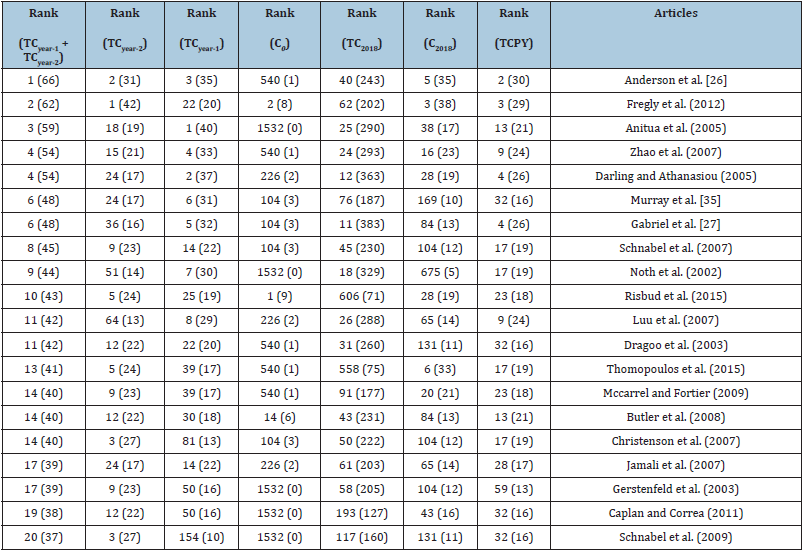
TCyear-1: number of citations from JCR year to articles in “year - 1”
TCyear-2: number of citations from JCR year to articles in “year - 2”
C0: total number of citations from web of science core collection in publication year
TC2018: total number of citations from web of science core collection since publication to the end of 2018
C2018: total number of citations from web of science core collection in 2018
TCPY: total number of citations per number of year (TC2018/year)
J Orthop Res was classified in the Web of Science category
of orthopedics. Figure 1 shows its journal impact factor and ranking
within the subject category from 1997 to 2018. Journal impact factor (JIF) slightly increased with fluctuate trend was found. Ranking of J Orthop Res
in the Web of Science category of orthopedics was decreased. How
quickly recent publications are cited is an important factor that can
affect IF [13]. In general, citations per publication for
articles in a journal would have a sharp increase after publication and
would reach a peak in a specific year. Figure 2 shows citations per
publication for each year of article [28]. The peak year of citations
per publication was found to be in the 5th full year since its publication year. The peak year could be different, for example, the 7th
year for Revista de Biología Tropical [12]. A special case was reported
that it does not show a peak, unlike previous findings, but shows an
increasing trend without a peak after 4th and 9th year for Journal of Membrane Science [1] and Polish Journal of Environmental Studies [25] respectively. Since IF only considers citations within two years after publication, the IF of J Orthop Res would be higher if it was calculated after a couple of years. It was pointed that IF
is not an unbiased criterion for all journals, since peak year
citations per publication of each journal can be different from each
other [25].
Figure 1: Rankings of Journal of Orthopaedic Research by journal impact factor (JIF) in Web of Science category
of orthopedics from 1997 to 2018.

Figure 2: Trend of citations per publication.
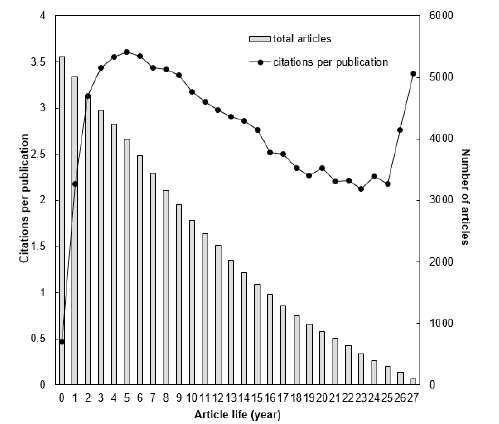
Trends of number of articles and citations per publication
Trends of number of articles shows a journal’s development and
citations per publication gives information about impact of a journal in
research world. Trends of the number of annual articles (TP) and their citations per publication (CPP2018 = TC2018/TP) has been proposed to discover the development of a journal [1,12]. Of the 5,329 articles published in J Orthop Res,
the annual number of articles increased about 3.2-fold from 101 in 1991
to 328 in 2018 (Figure 3). The number of annual articles were increased
fluctuate. Minima number of articles was found in 1994 with 94
articles. In 1991, 101 articles had the highest CPP2018 of 91, which can be attributed to the top ten most frequently cited articles by Caplan [29] with TC2018 of 2,243 (ranked 1st), [30] with TC2018 of 607 (ranked 2nd); and [31] with TC2018 of 497 (ranked 7th).
Figure 3: Trend of citations per publication.
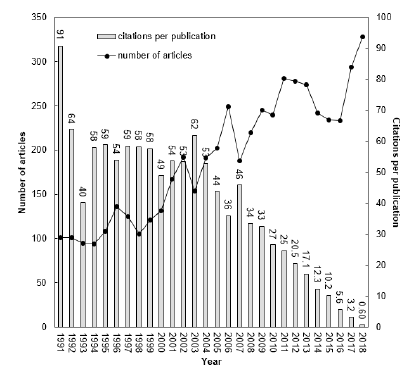
Characteristics of countries, institutions, and authors
Excluding 16 articles without any author affiliation information on
SCI-EXPANDED, the remaining 5,313 articles originated from 57 countries.
Among those articles, 4,295 (81% of 5,313 articles) were single country
articles, while 1,018 (19%) were internationally collaborative
articles. Table 3 shows the top 10 most contributing countries with six
publication indicators such as number total of articles (TP), country independent articles (IP), internationally collaborative articles (CP), first author articles (FP), corresponding author articles (RP), single author articles (SP), and citations per publication (CPP2018=TC2018/TP) [1,25]. The advantage of using CPP2018 and TC2018
is that it is invariant in comparison with the index of citations from
the Web of Science Core Collection which has to be updated from time to
time [24]. Four European countries, three Asian countries, two American
countries, and one Oceania country were ranked on the top 10 of total
articles. The most productive African country was Egypt with five
articles ranked 37th. USA dominated in J Orthop Res, ranking the first in all six publication indicators with TP of 2,974 articles (56% of 5,313 articles), IP of 2,309 articles (54% of 4,295 country independent articles), CP of 665 articles (65% of 1,018 internationally collaborative articles), FP of 2,720 articles (51% of 5,313 first author articles), RP of 2,520 articles (50% of 5,024 corresponding author articles), and SP of 19 articles (73% of 26 single author articles). USA also had the highest CPP2018 of 39. China ranked 6th in total articles but have lower CPP2018 of 19.
Figure 4: Top 18 authors with Y-index (j ≥ 17).
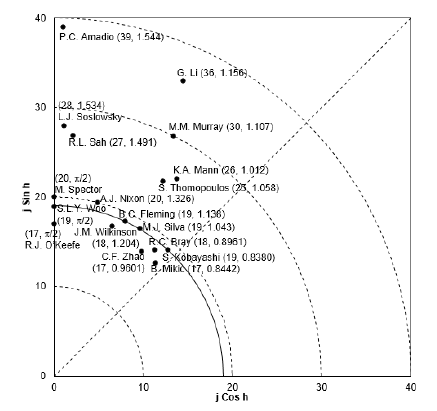
Table 3: Characteristics of the top 10 productive countries.
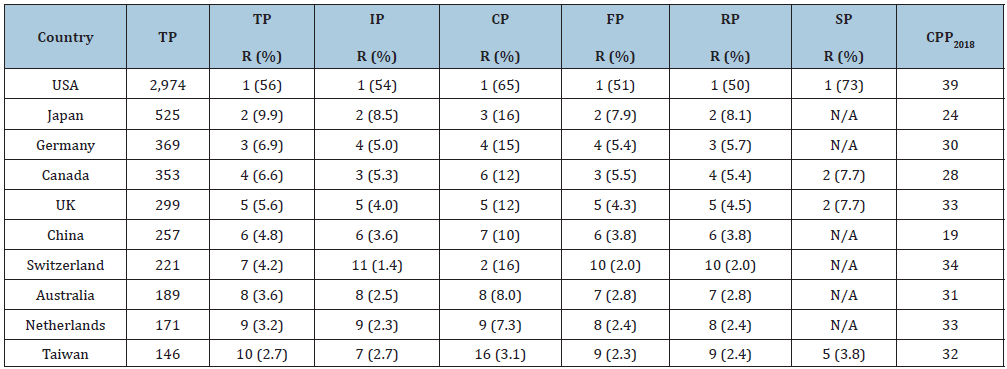
TP: Total number of articles; IP: Country independent articles; CP: Internationally collaborative articles; FP: First
author articles; RP: Corresponding author articles; SP: Single author articles; CPP2018: Citations per publication (CPP2018=TC2018/TP); N/A: Not available.
Table 4: Characteristics of the top ten productive institutes.

TP: Total number of articles; IP: Institute independent articles; ICP: Internationally collaborative articles; NCP: Nationally
collaborative articles; FP: First author articles; RP: Corresponding author articles; SP: Single author articles; CPP2018: Citations per publication (CPP2018=TC2018/TP); N/A: Not available.
Of the total 5,313 articles with affiliation information in
SCI-EXPANDED, 1,983 articles (37% of 5,313 articles) came from
independent institutions with CPP2018 of 35; 3,330 articles (63%) from inter-institutional collaborations with CPP2018
of 32; included 1,018 articles (31% of 3,330 inter-institutionally
collaborative articles) from international collaborations with CPP2018 of 31 and 2,312 articles (69%) from national collaborations with CPP2018 of 33. Percentage of the inter-institutional collaboration rate of J Orthop Res
(63%) was found much higher than that of J Membr Sci (38%) [1] and Pol J
Environ Stud (31%) [25]. Table 4 demonstrates the characteristics of
the top 10 productive institutions. Nine of them were located in USA and
one in Canada. Harvard University took the leading position in three of
the seven publication indicators with TP of 163 articles (3.1% of 5,313 articles), ICP of 53 articles (5.2% of 1,018 inter-institutionally collaborative articles), and NCP of 91 articles (3.9% of 2,312 nationally collaborative articles). University of Calgary in Canada ranked top with IP of 54 articles (2.7% of 1,983 institutional independent articles) while University of Pittsburgh ranked top with FP of 89 articles (1.7% of 5,313 first-author articles) and RP
of 76 articles (1.5% of 5,024 corresponding-author articles). In
addition, University of California Davis published 64 articles (ranked
18th) including the most single-author articles with SP
of four articles (15% of 26 single-author articles). Harvard
University, University of Pittsburgh, and Cornell University had the
highest CPP2018 of 48 respectively. In the top ten
productive institutes, Harvard University was the only one who published
single author articles in J Orthop Res. It has been generally
accepted that the first author and the corresponding author are the most
significant author position [32,33]. Three bibliometric indicators such
as total articles (TP), first author articles (FP), and corresponding author articles (RP)
were applied for an analysis of authors’ publications in a journal
[18,34]. Table 5 lists the top ten authors with at least 33 articles in J Orthop Res
Of the 5,329 articles with author’s information were published by
17,001 authors. There were 5,329 articles by 4,150 first authors, 4,889
articles with corresponding information by 2,732 corresponding authors,
and 26 single author articles by 21 authors. K.N. An contributed the
most with 68 articles. P.C. Amadio published the most corresponding
author articles with 38 while K.A. Mann and G. Li published the most
first author articles with 11 respectively. B. Martin published the most
first single author articles with three. S.L.Y. Woo with 44 articles
had the highest CPP2018 of 76 followed by G. Li with CPP2018 of 57 and L.J. Soslowsky with CPP2018 of 51. M.M. Murray had highest TCyear-1 + TCyear-2 of 314. Only two productive authors M.M. Murray and S.L.Y. Woo were journal impact factor contributors (JIF contributors) who published high journal impact factor contributing articles with TCyear-1 + TCyear-2
of 48 for articles by Murray et al. [35] and Gabriel et al. [36]
respectively. Bias is always considered in authorship analysis because
two or more authors may have the same name, or authors used different
names in their publications (e.g. name changes due to marriage) [19].
Table 5: Characteristics of the top ten productive authors.
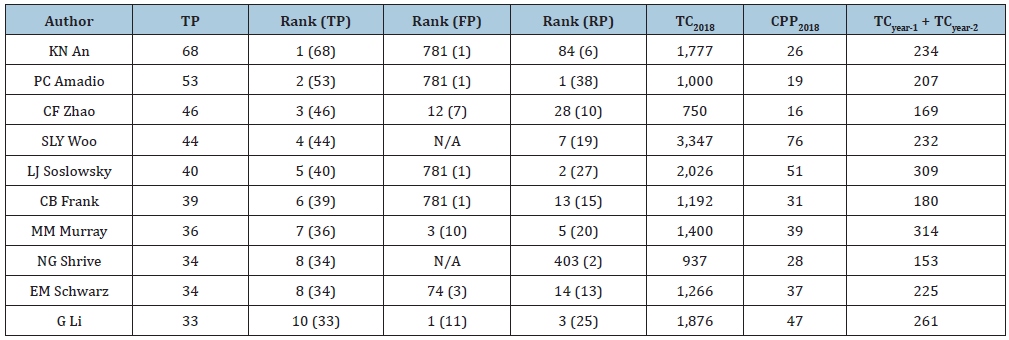
TP: Total number of articles; FP: First author articles; RP: Corresponding author articles; TC2018: The total number of
citations from web of science core collection since publication to the end of 2018; CPP2018: Citations per publication
(CPP2018=TC2018/TP); TCyear-1: Number of citations from JCR year to articles in “year - 1”; TCyear-2: Number of citations
from JCR year to articles in “year - 2”; N/A: not available.
Ho [18,22,37] proposed the Y-index which is related to the numbers of first author publications (FP) and corresponding author publications (RP). The Y-index with two parameters (j,h), assess both the publication potential and characteristics of contribution as a single index. The Y-index is defined as [22,37]:

j indicates publication potential. It was calculated by
using numbers of first authored articles and corresponding authored
articles as the Eq. (1). When one had larger j, it means its Y-index
located far away from origin of the polar coordinates. It indicates
that one published more articles as “important author” [37]. h
is a publication characteristic constant, that introduces the
distribution of the numbers of the corresponding authored articles and
the first authored articles. h could be calculated by using Eq.
(2). When the number of the first authored articles and the number of
the corresponding authored articles are the same, Y-index is located in the 45-degree (0.7854 rad) line with the same h of 0.7854. When j>0.7854, it means one published more corresponding author articles, and when j<0.7854, it means one published more first author articles. When h=0, j=number of first author articles, and h=p/2, j=number of corresponding author articles.
Of the 5,329 articles published in J Orthop Res,
4,889 articles (92% of 5,329 articles) with both first author and
corresponding author’s names in the SCI-EXPANDED were extensively
analyzed by using the Y-index. A total of 4,889 articles were
contributed by 15,911 authors. Only 1,803 authors (11% of the 15,911
authors) had both first- and corresponding-author articles in J Orthop Res In particular, 929 authors (5.8% of the 15,911 authors) had only corresponding-author articles (h=p/2); 334 (2.1%) authors had more corresponding-author articles than first-author articles (p/2>h>0.7854); 1,343 (8.4%) authors had the equivalent numbers of first-author and corresponding-author articles (h=0.7854); 126 (0.79%) authors had more first-author articles than corresponding-author articles (0.7854>h>0); and 11,162 (70%) authors had neither first- nor corresponding-author articles with Y-index of (0, 0). Figure 4 shows distribution of the Y-index (j, h) of the top 18 contributing authors with j³17 (j Cos h and j Sin h are chosen as the x and y coordinate axes). Each point has a coordinate (j, h) that could symbolize a single-author or multiple authors. j is contributed constant, an author with a higher j
indicates more articles as first or corresponding authors. P.C. Amadio
(39, 1.544), G. Li (36, 1.156), and M.M. Murray (30, 1.107) were the top
three contributors on J Orthop Res Contributing characteristics constant, h, could help to obtain the different proportion of corresponding author articles to first author articles. Y-index is helpful to distinguish the different performance of authors especially when j of authors is the same. For example, the j
of S.L.Y. Woo (19, p/2), B.C. Fleming (19, 1.138), M.J. Silva (19,
1.043), and S. Kobayashi (19, 0.838) were all the same of 19. However, h
of Woo was p/2, Fleming was 1.138; Silva was 1.043, and Kobayashi was
0.838. That means Woo had greater proportion of corresponding author
articles to first author articles than Fleming, Silva, and Kobayashi.
All top 18 authors published more corresponding author articles than
first author articles in J Orthop Res (h>0.7854).
Within these top 18 authors, M. Spector (20, p/2), S.L.Y. Woo (19, p/2),
and R.J. O'Keefe (17, p/2) had only corresponding author articles (h=p/2). Furthermore, K.N. An published the most 68 articles in J Orthop Res, including one first author and six corresponding articles with Y-index
(7, 1.406). A bias would appear in authorship analysis because two or
more authors may have the same name, or authors used different names in
their publications [19].
Highly cited articles
The total citation count was obtained from web of science core
collection, and this shows the total number of times that an article was
cited by the journals listed in the Web of Science Core Collection
database. The hotspots in a research field might be reflected by highly
cited articles [38]. Highly cited publications in a journal were also
investigated, for example JAMA-Journal of the American Medical Association [14], Water Research [19] and Polish Journal of Environmental Studies [25]. Articles with TC2018≥100, were generally called highly cited articles [37,39]. In J Orthop Res, 333 of 5,329 articles were highly cited articles with TC2018≥100.
The top 10 highly cited articles were listed in Table 6. All the top 10
highly cited articles were published in the 1990s. The earliest highly
cited was published in 1991 by Caplan [29], Schipplein [30] &
Athanasiou et al. [31]. The latest highly cited articles were published
in 1999 by Mckellop et al. [40] & Vunjak-Novakovic et al. [41].
Three highly cited articles with TC2018≥100 such as articles by Caplan [29], Markolf et al. [42] & Schipplein [30] in J Orthop Res were also ranked top ten in C2018.
The 10 highly cited articles were published by 45 highly cited authors
from 18 institutions. Three of the top ten articles were published by
authors from case western reserve university in USA. These top ten
articles were published by USA while one was international collaboration
with Switzerland. Caplan AI [29,43] and AJ Grodzinsky [41,44] published
two the top cited articles respectively (Table 6). Citation histories
of the top ten most frequently cited articles in J Orthop Res
Were shown in Figure 5. The highly cited article about mesenchymal stem
cells by Caplan [29] had different citation development trend. There is a
sharply increased trend after publication year of 1991 for two decades
to reach a plateau in recent years. Highly cited articles would not be
always with high citations. Article by Buschmann et al. [44] with TC2018 of 395 had low citation in the most recent year of 2018 with C2018 of 7.
Distribution of words in article title and author keywords
Figure 5: Citation histories of the top ten most frequently cited articles.

The title of article directly provided a picture of an article’s
theme. The synthesized analysis of words in article titles was developed
and applied in last decade [38]. Prepositions, articles, and
conjunctions were discarded in this analysis [45]. Bone (16% of 5,329
articles), model (11%), human (10%) cartilage (8.6%), cells (8.4%), knee
(8.1%), effect (6.7%), healing (6.7%), tendon (6.5%), and expression
(6.5%) were the top ten most frequently used single words in article
titles in the period of 1991-2018 in J Orthop Res Knee (8.1%),
osteoarthritis (4.5%), mesenchymal (2.6%), differentiation (2.1%), ACL
(1.6%), rotator (1.5%), cuff (1.5%), signaling (1.3%), head (1.2%), and
plasma (0.77%) in in article titles showed a notable increasing trend in
the study period.
Table 6: Top 10 highly cited articles in Journal of Orthopaedic Research.
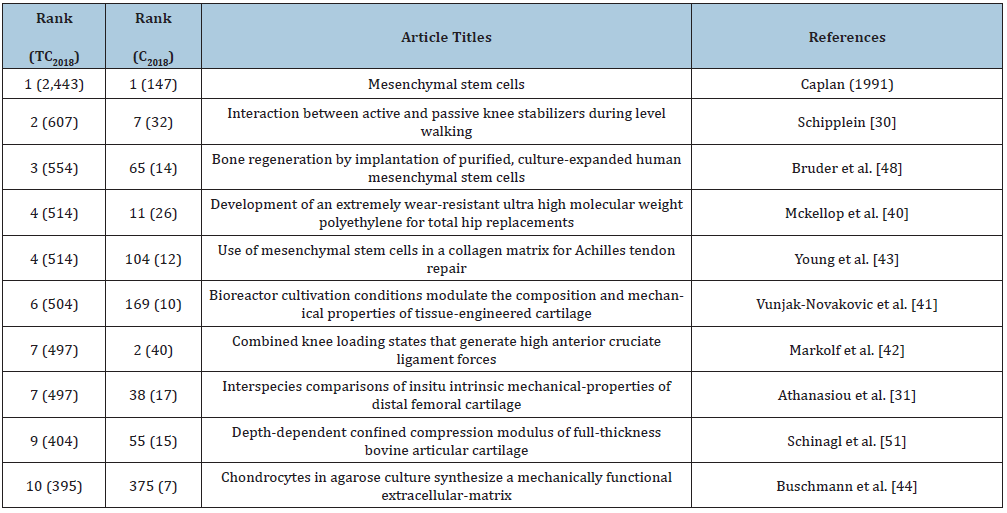
TC2018: total number of citations from web of science core collection since publication to the end of 2018.
C2018: total number of citations from web of science core collection in 2018.
Distribution of author keywords by years can be information for
research trends [46]. There were 7,789 author keywords in 4,037 articles
in J Orthop Res from 1991 to 2018. The most frequently used
keyword was “osteoarthritis” which was used in 309 articles (7.7% of
4,037 articles), followed by biomechanics (196 articles [47-51]; 4.9%),
cartilage (194 articles; 4.8%), knee (132 articles; 3.3%), fracture
healing (126 articles; 3.1%), collagen (108 articles; 2.7%), tendon (107
articles; 2.7%), animal model (97 articles; 2.4%), bone (90 articles;
2.2%), and anterior cruciate ligament (89 articles; 2.2%) were
associated with hot topics in J Orthop Res. In
addition, keywords included osteoarthritis, cartilage, biomechanics,
knee, intervertebral disc, fracture healing, animal model, tendon,
inflammation, and collagen, ranked top ten in the most recent period of
2012 and 2018.
Conclusion
In total of 5,589 publications in 11 Web of Science document
types were published in J Orthop Res from 1991 to 2018. Article
was the dominant document type and had a CPP2018 of 33 but review
had only half of CPP2018 with 16. The peak year of citations per
publication was found to be in the 5th full year since its publication
year. USA published the most articles and had higher citations per
publication. Harvard University contributed the most articles in J
Orthop Res. Results of citation analysis may have provided some
initial evidences that highly cited articles in a journal might not
contribute a lot to the journal’s impact factor. Articles related to
osteoarthritis, biomechanics, cartilage, knee, and fracture healing
were the most popular topics while intervertebral disc, tissue
engineering, and apoptosis were new focuses in the journal.
References
- Fu HZ, Ho YS (2015) A bibliometric analysis of the Journal of membrane science (1976-2010). Electronic Library 33(4): 698-713.
- Coronado RA,
Riddle DL, Wurtzel WA, George SZ (2011) Bibliometric analysis of
articles published from 1980 to 2009 in Physical Therapy, journal of the
american physical therapy association. Physical Therapy 91(5): 642-655.
- Wiles L,
Matricciani L, Williams M, Olds T (2012) Sixty-five years of Physical
Therapy: Bibliometric analysis of research publications from 1945
through 2010. Physical Therapy 92(4): 493-506.
- Coronado RA,
Wurtzel WA, Simon CB, Riddle DL, George SZ (2011) Content and
bibliometric analysis of articles published in the journal of
orthopaedic & sports physical therapy. Journal of Orthopaedic &
Sports Physical Therapy 41(12): 920-931.
- Yalcinkaya M,
Bagatur AE (2014) Articles published in acta orthopaedica et
traumatologica turcica between 2003-2012: Content, characteristics and
publication trends. Acta Orthopaedica et Traumatologica Turcica 48(5):
576-583.
- Mavrogenis
AF, Megaloikonomos PD, Panagopoulos GN, Mauffrey C, Quaile A, et al.
(2017) Best one hundred papers of International Orthopaedics: A
bibliometric analysis. International Orthopaedics 41(4): 689-697.
- Sheridan G,
Wisken E, Hing CB, Smith TO (2018) A bibliometric analysis assessing
temporal changes in publication and authorship characteristics in The
Knee from 1996 to 2016. Knee 25(2): 213-218.
- Russell AF,
Nguyen M, Bhuiya M, Likine EF, Fischer JP, et al. (2018) Comparative
analysis of bibliometric, authorship, and collaboration trends over the
past 30-year publication history of the journal of orthopaedic trauma
and injury. Journal of Orthopaedic Trauma 32(8): E327-E333.
- Brinker AR,
Liao JL, Kraus KR, Young J, Sandelski M, et al. (2018) Bibliometric
analysis of gender authorship trends and collaboration dynamics over 30
years of Spine 1985 to 2015. Spine 43(14): E849-E854.
- Seetharam A,
Ali MT, Wang CY, Schultz KE, Fischer JP, et al. (2018) Authorship trends
in the journal of orthopaedic research: A bibliometric analysis.
Journal of Orthopaedic Research 36(11): 3071-3080.
- Li YZ, Xu G,
Long X, Ho YS (2019) A bibliometric analysis of classic publications in
web of science category of orthopedics. Journal of Orthopaedic Surgery
and Research 14(1): 227.
- Monge-Nájera
J, Ho YS (2016) Bibliometry of the revista de biología
tropical/international journal of tropical biology and conservation:
Document types, languages, countries, institutions, citations and
article lifespan. Revista de Biología Tropical 64(3): 1223-1235.
- Garfield E (1999) Journal impact factor: A brief review. Canadian Medical Association Journal 161(8): 979-980.
- Garfield E (1997) Dispelling a few common myths about journal citation impacts. Scientist 11(3): 11.
- Ho
YS, Kahn M (2014) A bibliometric study of highly cited reviews in the
Science Citation Index Expanded™. Journal of the Association for
Information Science and Technology 65(2): 372-385.
- Wang
MH, Fu HZ, Ho YS (2011) Comparison of universities’ scientific
performance using bibliometric indicators. Malaysian Journal of Library
& Information Science 16(2): 1-19.
- Chuang KY, Wang MH, Ho YS (2011) High-impact papers presented in the
subject category of water resources in the Essential Science Indicators
database of the Institute for Scientific Information. Scientometrics
87(3): 551-562.
- Ho
YS (2012) Top-cited articles in chemical engineering in science
citation index expanded: A bibliometric analysis. Chinese Journal of
Chemical Engineering 20(3): 478-488.
- Wang MH, Yu TC, Ho YS (2010) A bibliometric analysis of the performance of water research. Scientometrics 84(3): 813-820.
- Li
Z, Ho YS (2008) Use of citation per publication as an indicator to
evaluate contingent valuation research. Scientometrics 75(1): 97-110.
- Ho
YS, Fu HZ (2016) Mapping of metal-organic frameworks publications: A
bibliometric analysis. Inorganic Chemistry Communications 73: 174-182.
- Ho YS (2014a) Classic articles on social work field in Social
Science Citation Index: A bibliometric analysis. Scientometrics 98(1):
137-155.
- Chiu WT, Ho YS (2005) Bibliometric analysis of homeopathy research
during the period of 1991 to 2003. Scientometrics 63(1): 3-23.
- Fu HZ, Wang
MH, Ho YS (2012) The most frequently cited adsorption research articles
in the Science Citation Index (Expanded). Journal of Colloid and
Interface Science 379(1): 148-156.
- Chuang
KY, Olaiya MU, Ho YS (2012) Bibliometric analysis of the Polish Journal
of Environmental Studies (2000-11). Polish Journal of Environmental
Studies 21(5): 1175-1183.
- Anderson DD,
Chubinskaya S, Guilak F, Martin JA, Oegema TR, et al. (2011)
Post-traumatic osteoarthritis: Improved understanding and opportunities
for early intervention. Journal of Orthopaedic Research 29(6): 802-809.
- Gabriel MT,
Wong EK, Woo SLY, Yagi M (2004) Distribution of in situ forces in the
anterior cruciate ligament in response to rotatory loads. Journal of
Orthopaedic Research 22(1): 85-89.
- Chuang KY, Huang YL, Ho YS (2007) A bibliometric and citation
analysis of stroke-related research in Taiwan. Scientometrics 72(2):
201-212.
- Caplan AI (1991) Mesenchymal stem cells. Journal of Orthopaedic Research 9(5): 641-650.
- Schipplein OD,
Andriacchi TP (1991) Interaction between active and passive knee
stabilizers during level walking. Journal of Orthopaedic Research 9(1):
113-119.
- Athanasiou KA,
Rosenwasser MP, Buckwalter JA, Malinin TI, Mow VC (1991) Interspecies
comparisons of insitu intrinsic mechanical properties of distal femoral
cartilage. Journal of Orthopaedic Research 9(3): 330-340.
- Gaeta TJ (1999) Authorship: “law” and order. Academic Emergency Medicine 6(4): 297-301.
- Mattsson P, Sundberg CJ, Laget P (2011) Is correspondence reflected
in the author position? A bibliometric study of the relation between
corresponding author and byline position. Scientometrics 87(1): 99-105.
- Ho HC, Ho YS (2015) Publications in dance field in Arts &
Humanities Citation Index: A bibliometric analysis. Scientometrics
105(2): 1031-1040.
- Murray MM,
Spindler KP, Abreu E, Muller JA, Nedder A, et al. (2007)
Collagen-platelet rich plasma hydrogel enhances primary repair of the
porcine anterior cruciate ligament. Journal of Orthopaedic Research
25(1): 81-91.
- Gabriel MT,
Wong EK, Woo SLY, Yagi M, Debski RE (2004) Distribution of in situ
forces in the anterior cruciate ligament in response to rotatory loads.
Journal of Orthopaedic Research 22(1): 85-89.
- Ho YS (2014b) A bibliometric analysis of highly cited articles in materials science. Current Science 107(9): 1565-1572.
- Ho YS, Satoh H, Lin SY (2010) Japanese lung cancer research trends
and performance in Science Citation Index. Internal Medicine 49(20):
2219-2228.
- Hsu YHE, Ho
YS (2014) Highly cited articles in health care sciences and services
field in science citation index expanded: A bibliometric analysis for
1958-2012. Methods of Information in Medicine 53(6): 446-458.
- McKellop H,
Shen FW, Lu B, Campbell P, Salovey R (1999) Development of an extremely
wear-resistant ultra-high molecular weight polyethylene for total hip
replacements. Journal of Orthopaedic Research 17(2): 157-167.
- Vunjak-Novakovic
G, Martin I, Obradovic B, Treppo S, Grodzinsky AJ, et al. (1999)
Bioreactor cultivation conditions modulate the composition and
mechanical properties of tissue-engineered cartilage. Journal of
Orthopaedic Research 17(1): 130-138.
- Markolf KL,
Burchfield DI, Shapiro MM, Shepard ME, Finerman GAM, et al. (1995)
Combined knee loading states that generate high anterior cruciate
ligament forces. Journal of Orthopaedic Research 13(6): 930-935.
- Young RG,
Butler DL, Weber W, Caplan AI, Gordon SL, et al. (1998) Use of
mesenchymal stem cells in a collagen matrix for Achilles tendon repair.
Journal of Orthopaedic Research 16(4): 406-413.
- Buschmann MD,
Gluzband YA, Grodzinsky AJ, Kimura JH, Hunziker EB (1992) Chondrocytes
in agarose culture synthesize a mechanically functional extracellular
matrix. Journal of Orthopaedic Research 10(6): 745-758.
- Xie SD, Zhang J, Ho YS (2008) Assessment of world aerosol research
trends by bibliometric analysis. Scientometrics 77(1): 113-130.
- Zhang GF, Xie SD, Ho YS (2010) A bibliometric analysis of world
volatile organic compounds research trends. Scientometrics 83(2):
477-492.
- Brimblecombe P, Grossi CM (2009) The bibliometrics of atmospheric environment. Atmospheric Environment 43(1): 9-12.
- Bruder SP,
Kurth AA, Shea M, Hayes WC, Jaiswal N, et al. (1998) Bone regeneration
by implantation of purified, culture-expanded human mesenchymal stem
cells. Journal of Orthopaedic Research 16(2): 155-162.
- Bujdoso E, Lyon WS, Braun T (1981) Scientometric study of health physics. Health Physics 41(2): 233-242.
- Monge-Nájera
J, Ho YS (2012) Costa rica publications in the science citation index
expanded: A bibliometric analysis for 1981-2010. Revista de Biología
Tropical 60(4): 1649-1661.
- Schinagl RM,
Gurskis D, Chen AC, Sah RL (1997) Depth-dependent confined compression
modulus of full-thickness bovine articular cartilage. Journal of
Orthopaedic Research 15(4): 499-506.





